Agilent Metrology Lab
Master in Environmental Metrology and Policy Program – for the Betterment of the World
Contents
- Agilent Gas Chromatography–Mass Spectrometer
- Agilent Liquid Chromatography–Time of Flight Mass Spectrometer
- Agilent Inductively Coupled Plasma–Mass Spectrometer
- Agilent Ultivo Triple Quadrupole Liquid Chromatography–Mass Spectrometer
- Nicolet™ iN™10 Infrared Microscope
- Thermo Scientific FlashSmart CHNS/O Elemental Analyzer
Thanks to the generous support of Agilent Technologies, Inc. through its instruments placement program, the Environmental Metrology and Policy Program has a fully-equipped environmental metrology laboratory in White Gravenor Hall 404 for teaching and research. The metrology lab hosts powerful research-grade instruments: Agilent Gas Chromatography-Mass Spectrometry (GC-MS), Agilent Liquid Chromatography-Mass Spectrometry (LC-MS), Aglient Inductively Coupled Plasma-Mass Spectrometry (ICP-MS), Agilent Liquid Chromatography-Triple-Q Mass Spectrometry (LC-MS/MS), Thermo Scientific FlashSmart CHNS/O Elemental Analyzer, and Nicolet™ iN™10 Infrared Microscope (the latter was donated by the US Secret Service). These instruments are used by EMAP students for their lab courses and independent research projects. The specifications of these instruments are briefly described as follows. For more information, please contact the lab director Dr. Dejun Chen.
Agilent GC-MS
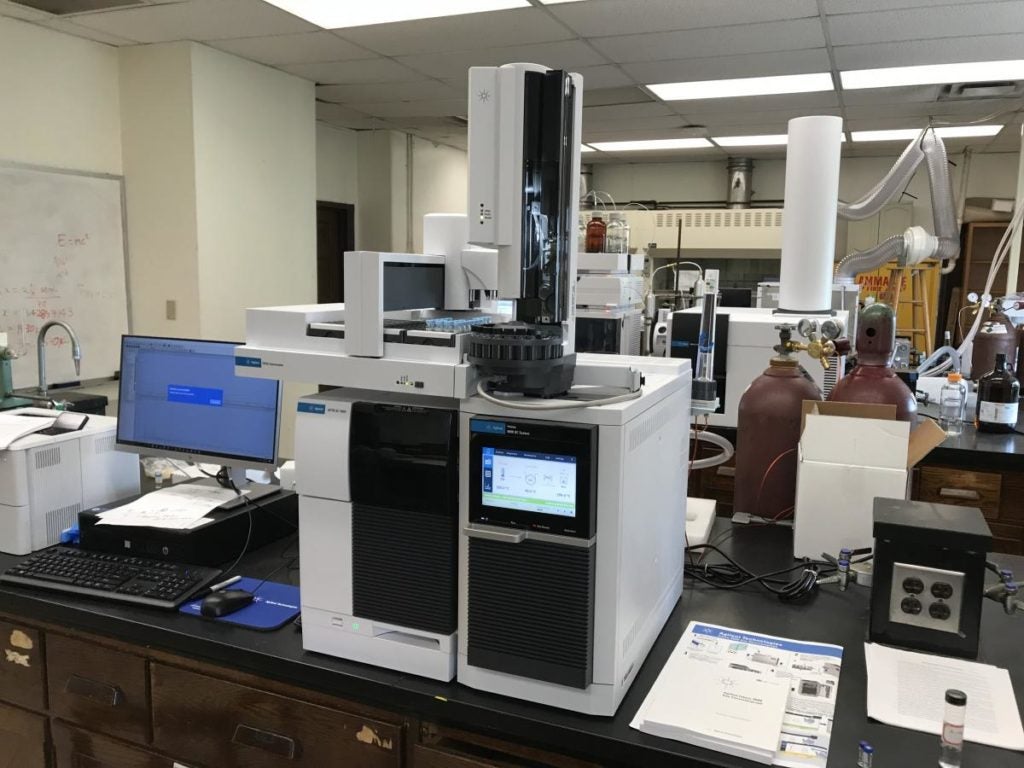
The Agilent GC-MS consists of an Intuvo 9000 ultra-fast GC system and a 5977B MS with an electron-ionization (EI) source and an autosampler. It’s built for labs that focus on applications such as environmental, chemical, petrochemical, food, forensic, and pharmaceutical analyses, and material testing, with the following specifications:
Intuvo 9000 GC
- Connections: GC-on-Chips (Ferrule-free)
- Heating: Direct Column Heating
- Oven temperature range: +10 °C to 450 °C
- Maximum temperature ramp: 250 °C/min
- Pressure control: 0.001 psi (range of 0 to 150 psi)
- Flow sensor accuracy: <±5 %
- Retention time repeatability: <0.008 % or <0.0008 minutes
5977B MS
- Detection limit: 10 fg
- Ion source temperature (EI): 150–350 °C
- Quadrupole temperature: 106–200 °C
- Mass range: 1.6–1,050 u
- Mass accuracy: ± 0.005
- Mass axis stability: Better than 0.10 u/48 hours
- Scan speed: 20,000 u/sec
Agilent LC-TOF MS
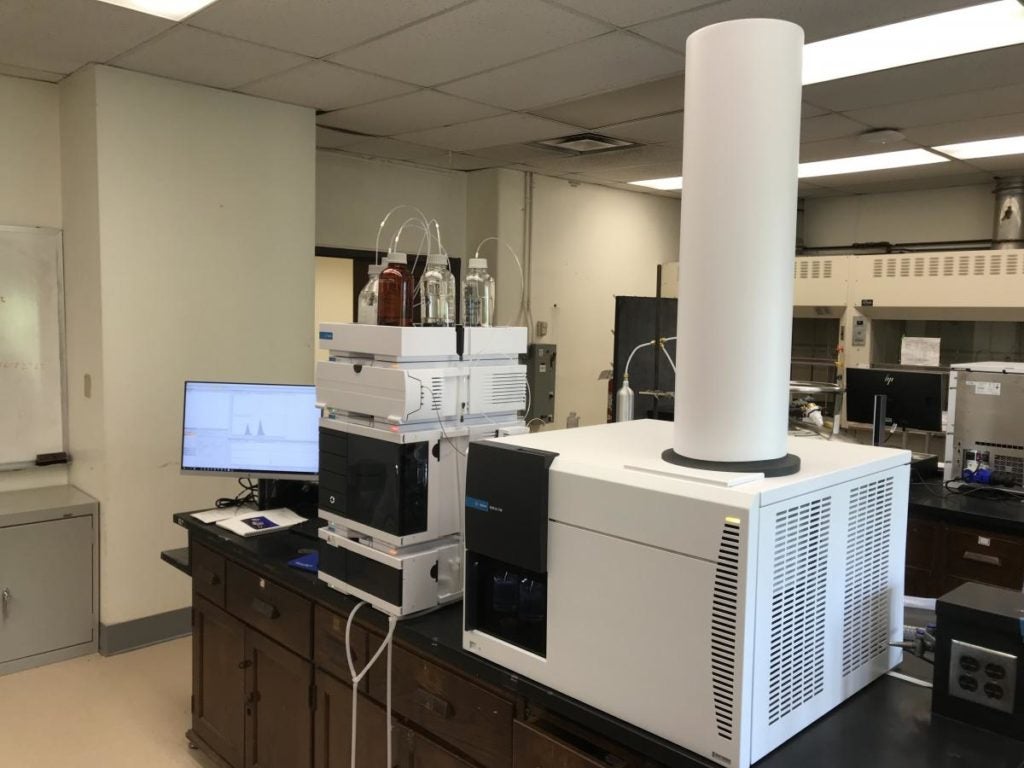
Agilent LC-TOF MS consists of a 1260 Infinity II LC system and a 6230 TOF mass analyzer with an autosampler. It brings powerful analytical capability to a wide range of applications in fields that include food, forensic, environmental, and life sciences, toxicology and pharmaceuticals, with the following specifications.
1260 Infinity II LC
- Degasser: 4 channels; up to 10 mL/min flow
- Pump pressure: Flexible Pump up to 800 bar
- Multisampler: 0 to 100 μL single-stroke injection
- Multicolumn thermostat: 10 degrees below ambient to 85 °C; up to four 30 cm columns
6230 TOF MS
- Detection limit: 1 pg
- Ion source: Dual ESI (Electrospray ionization)
- Signal-to-noise ratio: > 10:1 at 1 pg injection
- Mass range: 25 to 20,000 u
- Mass resolving power: 22,000 for 1,522 m/z
- Mass accuracy: < 1 ppm
- Mass temperature stability: 2 ppm accuracy within 2 °C drift per h
- Spectral acquisition rate: 30 spectra/second for m/z 100 to 3,200
Agilent ICP-MS
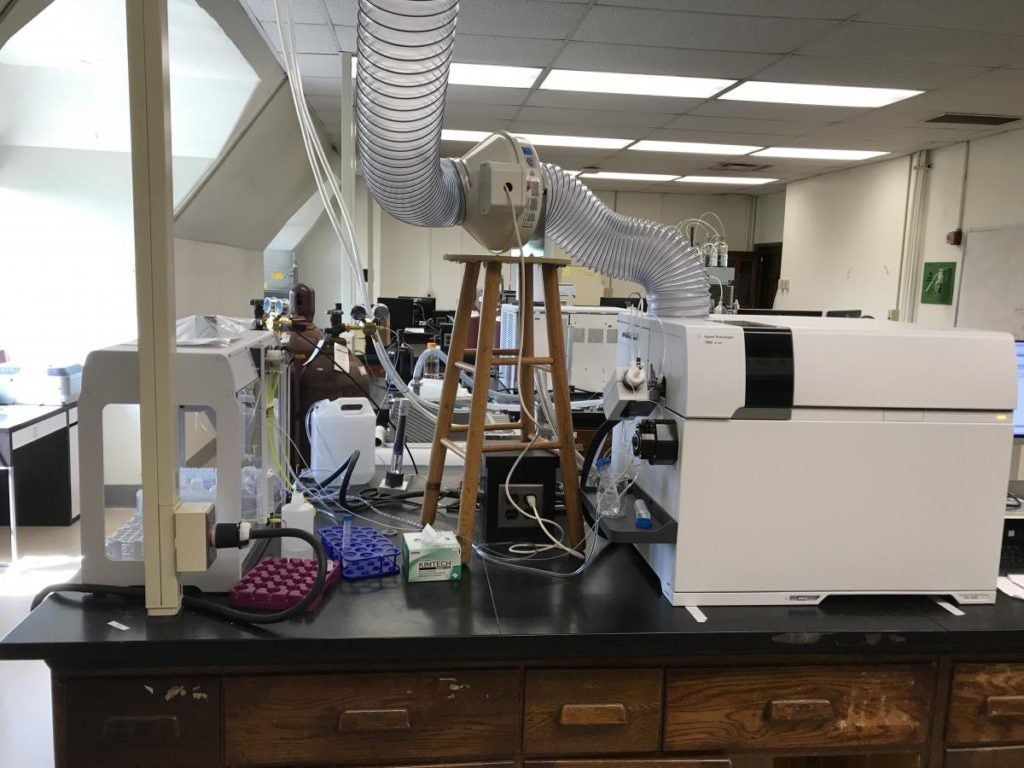
The Agilent ICP-MS consists of a 7800 ICP and a quadrupole MS with an autosampler. It combines proven, robust hardware, auto-optimization tools, and pre-set methods to simplify routine analysis of drinking water, environmental wastes and elemental impurities in pharmaceutical product solutions, with the following specifications.
7800 ICP
- Nebulizer: MicroMist (borosilicate glass)
- Spray chamber: Scott-type double-pass (quartz) –5 °C to +20 °C
- Plasma: 27 MHz, Variable-frequency impedance matching 500 W to 1600 W
- Torch Sampling depth: 3 to 28 mm in 0.1 mm steps
- Sampling cone: 1 mm diameter orifice
- Skimmer cone: 0.4 mm diameter orifice
- Collision cell gas: He (He-Gas Mode)
Quadrupole MS
- Detection limit: 0.1 ppt for 209Bi (No-Gas mode)
- Mass range: 2–260 u
- Mass accuracy: 0.3 – 1.0 u
- Mass axis stability: < 0.05 u per day < 0.1 u per 6 months
- Minimum dwell time: 3 ms
- Oxide: <1.5% for CeO/Ce
- Isotope ratio precision: <0.1% RSD for 107Ag/109Ag
Agilent Ultivo Triple Quadrupole LC-MS
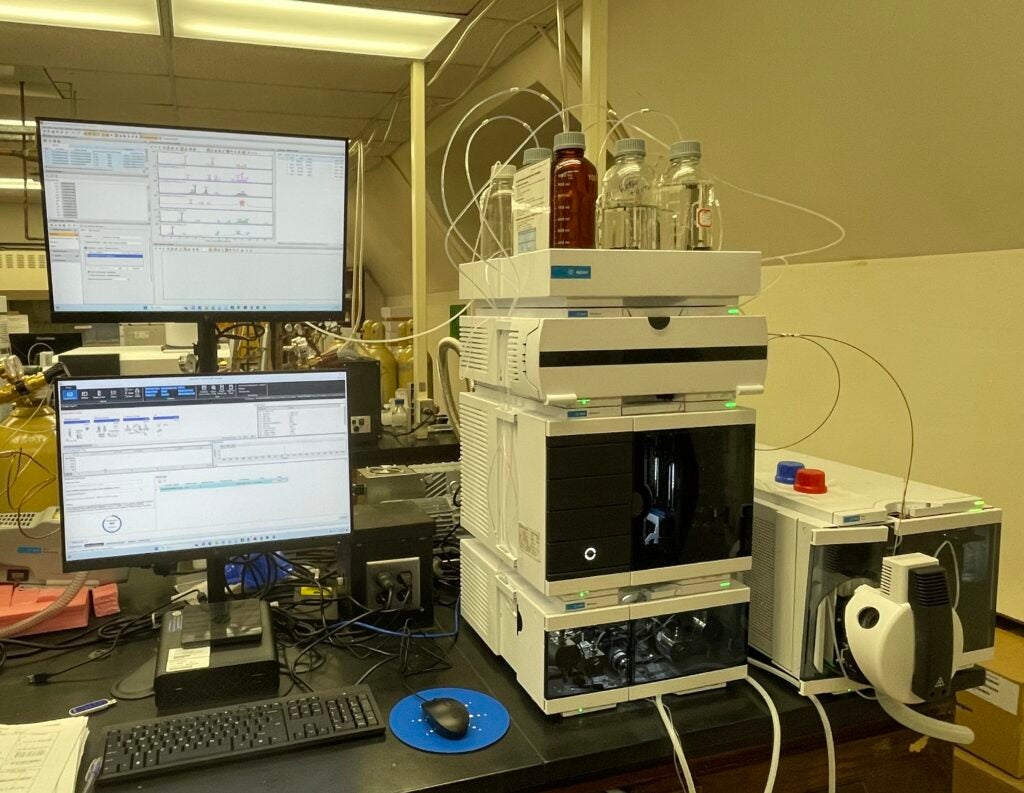
Ultivo is a compact, stackable triple quadrupole LC/MS/MS that eliminates the MS footprint by incorporating the mass spectrometer into the HPLC stack. Representing a transformative approach to triple quadrupole mass spectrometry, Ultivo provides the fit-for-purpose, straightforward, and rugged LC/MS analysis you expect from larger comparable systems, but at a fraction of their size.
Features
- Smallest footprint of any LC/TQ on the market, delivering a price/performance per square foot ratio that leads to reduced costs and the fastest path to achieving ROI
- Multiple ion source configurations available, including Agilent Jet Stream and traditional ESI
- VacShield eliminates the need to vent the system while performing ion injector maintenance, minimizing maintenance downtime and increasing laboratory efficiency
- Cyclone ion guide compresses the ion beam without loss of signal, resulting in higher ion transmission efficiencies and enhanced data quality
- Vortex collision cell provides efficient dissociation of ions in the cell, improved focusing and transmission of ions, and rapid clearance of the cell between mass transitions, thereby allowing for more MRMs/sec, zero crosstalk, and greater confidence in results by removing noisy background
- Screen, confirm, and quantitate with triggered MRM (tMRM), which combines fast and sensitive MRM quantitation with the generation of a product ion spectrum for compound screening and confirmation
- Intuitive ‘Quant-My-Way’ software and the MassHunter Productivity App boost productivity by up to 40%, require less need for operator training, reduce time spent reviewing data, and simplify report generation
- Enhanced maintenance feedback (EMF) features deliver smart, self-aware diagnostics to ensure optimum uptime and help drive down maintenance costs
- Built-in technical controls combined with procedural controls ensure the security of your data, control access, and facilitate compliance as defined by US FDA 21 CFR Part 11, EU Annex 11 and similar national electronic record regulations
Specifications
Collision Cell Clearance Time: <1 ms
Dimensions (WxDxH): 32 cm x 88 cm x 39.5 cm
IDL Sensitivity (positive): <20 fg Reserpine on-column, <20 ppt; IDL spec only for new LC/MS systems using Agilent Jet Stream + checkout column + 1290 Infinity II LC
Instrument Health Tracking: Early Maintenance Feedback System
Ion Source: ESI AJS APCI
MRM Speed: 500 MRM transitions/s
Mass Range: m/z 5-1400
Minimum MRM Dwell Time: 1 ms
Polarity Switch Speed: <20 ms
Quad Resolution (FWHM): Unit = 0.7 Da Wide = 1.2 Da Widest = 2.5 Da
Scan Speed: 15000 Da/s
Nicolet™ iN™10 Infrared Microscope

Nicolet™ iN™10 Infrared (IR) Microscope is an intuitive, innovative and integrated infrared microscope and was donated by the Criminal Investigative Division of US Secret Service. The IR microscope is an ideal instrument for analyzing environmental samples that include microplastics, polymers, rubbers, packaging, paints, coatings, compounding, microelectronics, pharmaceuticals, cement, cosmetics, textiles, fibers, pigments, paper chemicals, inks and adhesives, etc. Its specifications are as follows.
IR Spectrometer
- Operational modes: Transmission, reflection, and attenuated total reflection (ATR)
- Scan speed: Up to 10 scans per second @ 16 cm-1
- Spectral range: 7600–450 cm-1
- Spectral resolution: 0.4 cm-1 maximum
- Spectral signal over noise ratio: 25,000:1 @ 4 cm-1 2min
Microscope
- Working distance: 16 mm x 16 mm maximum
- Field of view: Real-time 500 micron
- Space resolution of the MicroTip Ge-ATR crystal window: As small as 50 microns
Thermo Scientific FlashSmart CHNS/O Elemental Analyzer
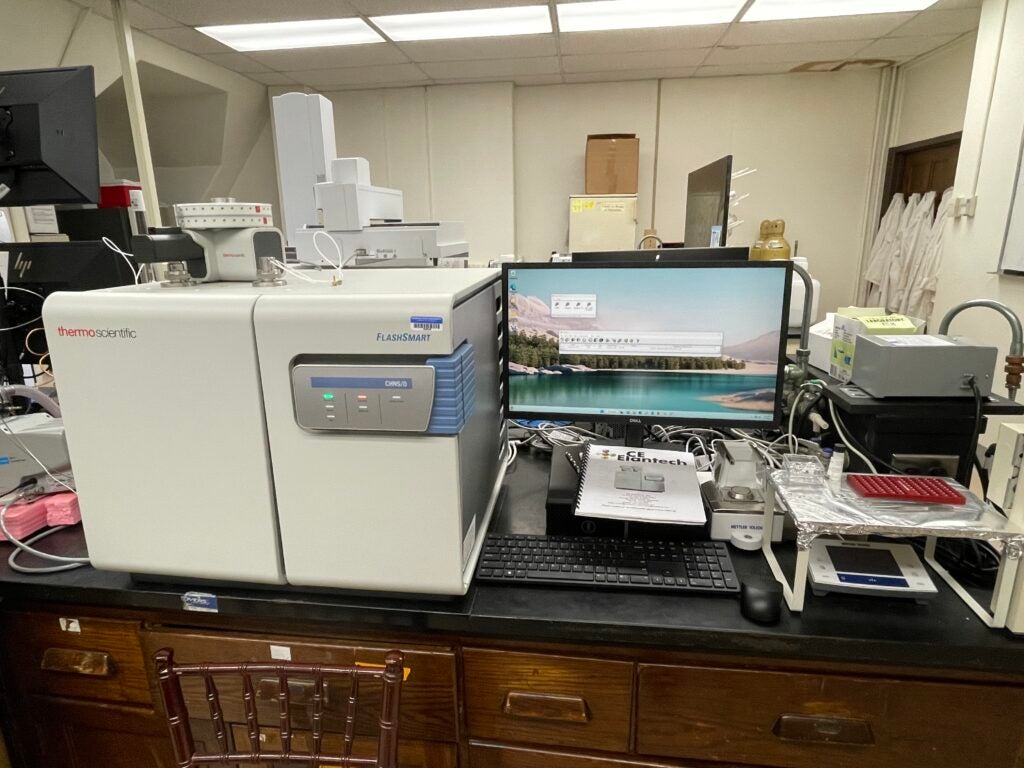
The Thermo Scientific FlashSmart CHNS/O Elemental Analyzer is equipped with two independent furnaces each connected with a separate analytical circuit. The switch between analysis can be done sequentially and are completely automated through the MultiValve Control (MVC) Module. Carbon, nitrogen, hydrogen, and sulfur determination by combustion analysis and oxygen determination by pyrolysis are enabled with the current setting for the characterization of various solid materials in pharmaceutical, cosmetics, and other material research fields for quality control and R&D purposes. The Thermo Scientific FlashSmart Elemental Analyzer is the optimal solution for the analysis of CHNS/O in terms of accuracy, reproducibility, automation, speed of analysis, and cost per analysis.
Instrument Specifications
Detector: Thermal Conductivity Detector (TCD)
Carrier Gas: Helium (40 psi)
Carrier Gas Flow Rate: 100 to 140 mL/min
Standby Gas: Nitrogen (40 psi)
Standby Gas Flow Rate: 10 mL/min
Combustion Gas: Oxygen (45 psi)
Combustion Gas Flow Rate: 250 mL/min
Furnace Temperature (Operation): 950 °C (Combustion, Left), 1060 °C (Pyrolysis, Right)
Furnace Temperature (Standby): 476 °C (Combustion, Left), 531 °C (Pyrolysis, Right)
Sample Size: 0.5 to 2 mg
Autosampler: 32 Positions Each
